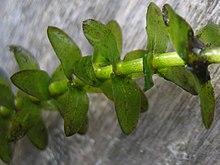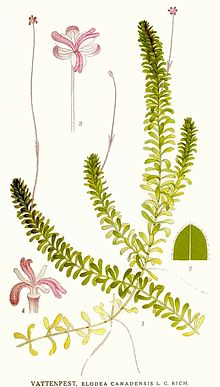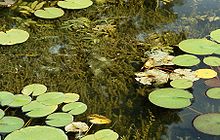Waterweed
| Waterweed | ||||||||||||
|---|---|---|---|---|---|---|---|---|---|---|---|---|

Canadian waterweed ( Elodea canadensis ) |
||||||||||||
| Systematics | ||||||||||||
|
||||||||||||
| Scientific name | ||||||||||||
| Elodea | ||||||||||||
| Michx. |
The plant genus Wasserpest ( Elodea ) belongs to the frog-bite family (Hydrocharitaceae). The approximately six submerged aquatic plant species are originally widespread in the New World ; three of them are neophytes in many areas of the world .

description

Appearance and leaves
Elodea species are perennial herbaceous plants . They are submerged aquatic plants , so they live submerged in fresh water and have roots in the water bed. No rhizomes or runners are formed. They form roots at the nodes . Their stems are heavily branched, the side branches have two lateral bracts. The green, flexible, slender stems can be up to 3 meters long, depending on the species.

The against-constant depending on the type or at a distance of a few millimeters lively threes mostly or rarely four to seventh-placed leaves are more or less clearly divided into leaf sheath and blade. The leaf blades are oblong or linear-lanceolate with an arched, rounded blade base and a rounded, pointed upper end and finely serrated leaf edge. The top and bottom of the sheet are the same color.
Inflorescences and flowers

Waterweed species are dioeciously separated sexes ( diocesan ), so there are male and female specimens; but hermaphroditic flowers are also sometimes found. Their single-flowered inflorescences are sitting or on inflorescence shafts in the leaf axils. The bracts are notched. The male and female inflorescences are free-flowing, so they are located on the surface of the water by extending the base of the bloom tube.
The mostly unisexual flowers are radial symmetry and threefold. The bracts form a long, thin tube. There are three sepals . The three petals are narrow and white. The male flowers contain three to mostly nine stamens , with the innermost three mostly fused together over half their length, the others being free. The anthers are oval. The pollen grains are in monads or tetrads. The female flowers have a subordinate, single-chamber ovary . The slender style ends in three simple or bilobed scars.
Fruits and seeds
The smooth, berry-like fruits are cylindrical to egg-shaped or elongated to lanceolate-ellipsoidal, are broken up into irregular parts by their mucus content and contain a few seeds. The cylindrical to spindle-shaped seeds are smooth or coarsely hairy.

Systematics and distribution
The genus Elodea was established in 1803 by André Michaux in Flora Boreali-Americana , Volume 1, p. 20. The type species is Elodea canadensis Michx. The generic name Elodea is derived from the Greek word helodes for swampy or swamp-dwelling. Synonyms of Elodea Michx. are: Anacharis Rich. nom. illeg., Serpicula Pursh nom. illeg., Apalanthe Planch. , Philotria Raf. , Udora Nutt. , Diplandra Bertero , Hydora Better .
The genus Elodea belongs to the subfamily Anacharidoideae within the family Hydrocharitaceae .
The genus Elodea is originally widespread in the New World .
There are about six species of Elodea :
- Elodea bifoliata H.St.John (Syn .: Elodea longivaginata H.St.John , Elodea nevadensis H.St.John ): It is distributed from southern Canada to the western and central USA .
- Argentine waterweed ( Elodea callitrichoides (Rich.) Casp. , Syn .: Elodea ernstiae H.St.John , Elodea richardii H.St.John ): It is distributed from southern Uruguay to Argentina , and is a neophyte in Western Europe .
- Canadian waterweed ( Elodea canadensis Michx. , Syn .: Elodea occidentalis (Pursh) H.St.John nom. Superfl.): It is widespread from southern Canada to the USA. It has been naturalized in large areas of Europe since the 19th century.
- Elodea granatensis Humb. & Bonpl. (Syn .: Elodea guyanensis Rich. , Elodea orinocensis Rich. ): It iswidespreadin tropical South America .
- Narrow-leaved waterweed , Nuttall's waterweed ( Elodea nuttallii (Planch.) H.St.John , Syn .: Elodea minor (Engelm. Ex Casp.) Farw. , Elodea columbiana H.St.John ): It is from southern Canada to the Common in the USA, it is a neophyte in Northwest and Central Europe.
- Elodea potamogeton (Bertero) Espinosa (Syn .: Elodea chilensis (Planch.) Casp. , Egeria chilensis Planch. Ex Benth. & Hook. F. Nom. Inval., Egeria matthewsii (Planch.) Planch. Ex Benth. & Hook. f. nom. inval., Elodea matthewsii (Planch.) H.St.John , Elodea peruviensis H.St.John , Elodea titicacana H.St.John ): It is distributed in western South America to Chile .

Spread as neophytes
In Europe, Canadian waterweed ( Elodea canadensis ), narrow-leaved waterweed , Nuttall's waterweed ( Elodea nuttallii ) and Argentine waterweed ( Elodea callitrichoides ) occur as neophytes . Their settlement and spread in Europe was facilitated by targeted releases (for example by aquarium keepers) and further promoted, among other things, by dispersal via shipping and by water birds.
At least the two North American species, which can be found in Europe with climatic conditions comparable to those in their homeland, have grown here since the middle of the 19th century ( Elodea canadensis ), when Elodea was the first aquarium plant to be introduced, or in the last few decades ( Elodea nuttallii ) spread rapidly and are now part of the common inventory of species in many ponds, lakes and moats.
The waterweed species thrive particularly in summer warm, nutrient-rich, but not excessively polluted, standing or slowly flowing water (ponds, ponds, reservoirs and quarrying ponds, ditches, rivers etc.) with sandy-muddy bottoms. It lives up to its name waterweed by quickly developing submerged dominant populations, real "underwater forests". While Elodea canadensis has been widespread throughout Germany and beyond for a long time, Elodea nuttallii was only known regionally towards the end of the 1980s (especially in the northwest and in the Rhine area), but has since spread significantly.
Propagation and overwintering
In Europe only purely female plants are known, while in North America there are also male plants.
In Europe, the species of waterweed reproduce exclusively by breaking off and growing on the brittle stems. Each separated fragment is instantly independent and self-sufficient and develops into a complete plant in a short time. In autumn the waterweed forms turions , each of which consists of a package of tightly packed leaves and leaf systems. They grow into new plants the following spring.
The "green ghost" - invasive plant
The poet Hermann Löns wrote in the Hannoversche Tageblatt on October 9, 1910 about the Canadian waterweed:
“ There was a terrible howling and chattering of teeth everywhere, because the day did not seem distant, as all inland waters of Europe were filled to the brim with the herb, so that no more ships sail, no more people bathe, no more ducks and no more Fish could swim more (...). "

The strong and fast, almost explosive growth and spreading ability of the waterweed has long been known in Europe. In the meantime, however, Elodea canadensis has declined again and is barely forming mass populations. In contrast, Elodea nuttallii has been causing increasing problems since the 1990s . Examples are the occurrences along the Ruhr in North Rhine-Westphalia , especially the reservoirs Hengsteysee , Harkortsee , Kemnader See and the Listertalsperre in the Sauerland . There it hinders water management (clogging of run-of-river power stations and locks), shipping , water sports and fishing due to its mass occurrence . The responsible Ruhr Association is now regularly reducing the stocks there with its own mowing boat.

As an ecological interaction, it should be mentioned that the spread of the waterweed can occur at the expense of other, less competitive underwater plants belonging to the spawning weed and chandelier algae communities . In the meantime, however, the waterweed species seem to be competing with each other in Central Europe, with the long-established Elodea canadensis apparently being partially displaced by the “younger” Elodea nuttallii . The autumn death of plants is problematic, the excess of biomass of which can lead to the overturning of water bodies. Meanwhile, many stocks, however, have stabilized at a more moderate measure because, among other native nematodes eat their buds and they limit the growth by. According to popular belief, the plant should "move on every seven years".
A positive feature is the strong photosynthetic activity, which is clearly visible when the sun is shining through the air bubbles rising up like a string of pearls. Their comparatively high oxygen production rate can significantly invigorate a body of water. The dense underwater forests also offer shelter and egg-laying places for fish and other aquatic animals. The plant has a high nutritional value - the dry matter contains 18% protein, 42% starch and 2.5% fat - which is why it was even recommended as fodder in the past. According to the latest research, the plant is even suitable for decontaminating water because it stores radioactive cobalt . Targeted removal of the plant can therefore significantly reduce the cobalt content of a body of water.
Use as an ornamental plant
Elodea canadensis is used (like the slower growing Elodea nuttallii ) as a pond aquarium plant. It does not make any special demands on the water, but it does need a lot of light. It can be propagated simply by planting cuttings .
swell
- Robert R. Haynes: Hydrocharitaceae. : Elodea Michaux - the same text online as the printed work , In: Flora of North America Editorial Committee (Ed.): Flora of North America North of Mexico. Volume 22: Magnoliophyta: Alismatidae, Arecidae, Commelinidae (in part), and Zingiberidae , Oxford University Press, New York and Oxford, 2000. ISBN 0-19-513729-9 (sections description, systematics and distribution)
Individual evidence
- ↑ a b c d e f g h i j Rafaël Govaerts (Ed.): Elodea. In: World Checklist of Selected Plant Families (WCSP) - The Board of Trustees of the Royal Botanic Gardens, Kew . Retrieved August 25, 2014.
- ↑ a b c d e f g h i j k l m n o Robert F. Thorne: Jepson Manual Treatment .
- ↑ a b c d e f g h i j k l m Robert R. Haynes: Hydrocharitaceae. : Elodea Michaux - the same text online as the printed work , In: Flora of North America Editorial Committee (Ed.): Flora of North America North of Mexico. Volume 22: Magnoliophyta: Alismatidae, Arecidae, Commelinidae (in part), and Zingiberidae , Oxford University Press, New York and Oxford, 2000. ISBN 0-19-513729-9
- ↑ a b c d e f g h i j k Friedrich Markgraf : Hydrocharitaceae frog-bite plants. In: Gustav Hegi : Illustrated flora of Central Europe. 3rd edition, Volume I, Part 2. pp. 175-196. Paul Parey Publishing House, Berlin / Hamburg 1981, ISBN 3-489-51020-8 .
- ↑ a b c d e f Robert F. Thorne, C. Barre Hellquist, Robert R. Haynes: Elodea in Jepson Flora Project (eds.): Jepson eFlora , 2013.
- ↑ First publication scanned at biodiversitylibrary.org .
- ↑ Elodea at Tropicos.org. Missouri Botanical Garden, St. Louis, accessed August 25, 2014.
- ^ A b Elodea in the Germplasm Resources Information Network (GRIN), USDA , ARS , National Genetic Resources Program. National Germplasm Resources Laboratory, Beltsville, Maryland. Retrieved August 25, 2014.
- ↑ a b c James Edgar Dandy : Hydrocharitaceae . In: TG Tutin, VH Heywood, NA Burges, DM Moore, DH Valentine, SM Walters, DA Webb (eds.): Flora Europaea . Alismataceae to Orchidaceae (Monocotyledones). tape 5 . Cambridge University Press, Cambridge 1980, ISBN 0-521-20108-X , pp. 4–5 ( Elodea Michx. In the Google book search).
- ^ Wilhelm Berndt: The fresh and sea water aquarium, its facility and its living world. Theod. Thomas, Leipzig 1911, p. 30 f.
- ↑ a b c d Mass development of aquatic plants in the Ruhr reservoirs - Nusch / Brinkmann: Flat lake research in Germany of the Leibniz Institute for Freshwater Ecology and Inland Fisheries = IGB. ( Memento from January 2, 2010 in the Internet Archive )
- ↑ a b Ingo Kowarik : Biological Invasions. Neophytes and Neozoa in Central Europe. Ulmer, Stuttgart 2002, ISBN 3-8001-3924-3 , doi: 10.1002 / biuz.200390126 .
- ↑ Christel Kasselmann : aquarium plants. Ulmer Verlag, Stuttgart 1995; 2nd, revised and expanded edition 1999, ISBN 3-8001-7454-5 , p. 286 f.
- ↑ Elodea canadensis as a pond and aquarium plant.

